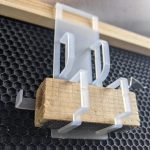
It’s official – Mason bees are flying! Make sure you have new, clean nesting materials for them and for the other bee species that follow throughout the summer. If you have overwintered cocoons, get them out now. You can use one of our release tubes (pictured left) that allow the bees to emerge but not to renest in the same old dirty straws.
Mason bees only fly from about mid-March to early June. If you don’t have plants blooming then, such as fruit trees or Mahonia, you won’t be able to support mason bees. Don’t worry though because there are many other cavity nesting species that are happy for a clean safe place to nest.

Houdini Fly Maggots. Photo Credit: Crown Bees
We have always stressed the importance of local mason bees but it is now of dire importance not to purchase bees over the internet! There is a new, imported parasite, the Houdini fly, that’s infesting mason bee larvae in their nesting tubes in the Pacific Northwest and New York state. Buying uninspected cocoons from out of state (Colorado is currently free of this parasite) will only foster the spread of this deadly parasite. For more info watch a video from Crown Bees, our supplier of bee nesting materials. Pictured right are the maggots that you’d find instead of a mason bee cocoon.
 If honeybees are your thing, help them through the early spring with pollen sub patties and plenty of heavy syrup as long as they’ll take it. We stock MegaBee patties and ProSweet liquid feed. Then get ready for swarm season! We have everything for making splits or just adding more space.
If honeybees are your thing, help them through the early spring with pollen sub patties and plenty of heavy syrup as long as they’ll take it. We stock MegaBee patties and ProSweet liquid feed. Then get ready for swarm season! We have everything for making splits or just adding more space.
If your bees didn’t make it or if you’re just starting out, get your bees ordered now. Suppliers are listed on the Colorado State Beekeepers Association’s website. If you’re nervous about driving home with your bees, we have special mesh bags that go over a nuc or a package. Hanging the queen cage without drawn comb can be tricky, so we’re trying the queen cage hangers this year. They hold any type of cage securely. New bees will need lots of syrup! Try a one or two gallon in-hive feed bucket.

Live Bee Ventilated Bag

Queen Cage Hanger

In-hive feed bucket
